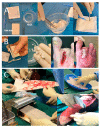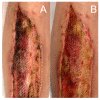The Use of Intact Fish Skin Grafts in the Treatment of Necrotizing Fasciitis of the Leg: Early Clinical Experience and Literature Review on Indications for Intact Fish Skin Grafts
- PMID: 37762941
- PMCID: PMC10532083
- DOI: 10.3390/jcm12186001
The Use of Intact Fish Skin Grafts in the Treatment of Necrotizing Fasciitis of the Leg: Early Clinical Experience and Literature Review on Indications for Intact Fish Skin Grafts
Abstract
Background: Necrotizing fasciitis (NF) is a serious infectious disease that can initially place the patient's life in danger and, after successful surgical and antibiotic treatment, leaves extensive wounds with sometimes even exposed bones and tendons. Autologous skin grafts are not always possible or require adequate wound bed preparation. Novel intact fish skin grafts (iFSGs; Kerecis® Omega3 Wound, Kerecis hf, Isafjördur, Iceland) have already shown their potential to promote granulation in many other wound situations. Faster wound healing rates and better functional and cosmetic outcomes were observed due to their additionally postulated anti-inflammatory and analgesic properties. Therefore, iFSGs may also be essential in treating NF. We present our initial experience with iFSGs in treating leg wounds after NF and review the literature for the current spectrum of clinical use of iFSGs.
Case presentations: We present two male patients (aged 60 and 69 years) with chronic or acute postsurgical extensive leg ulcers six weeks and six days after necrotizing fasciitis, respectively. Both suffered from diabetes mellitus without vascular pathologies of the lower limbs. A single application of one pre-meshed (Kerecis® Graftguide) and one self-meshed 300 cm2 iFSG (Kerecis® Surgiclose) was performed in our operation room after extensive surgical debridement and single circles of negative wound pressure therapy. Application and handling were easy. An excellent wound granulation was observed, even in uncovered tibia bone and tendons, accompanied by pain relief in both patients. Neither complications nor allergic reactions occurred. The patients received autologous skin grafting with excellent functional and cosmetic outcomes.
Conclusions: iFSGs have the potential to play a significant role in the future treatment of NF due to the fast promotion of wound granulation and pain relief. Our experience may encourage surgeons to use iFSGs in NF patients, although high-quality, large-sized studies are still required to confirm these results. The observed effects of iFSGs on wounds associated with NF may be transferred to other wound etiologies as well.
Keywords: chronic wounds; fish skin grafts; gangrene; intact fish skin; necrotizing fasciitis; negative pressure wound therapy; skin substitutes; skin transplantation; wound healing; wounds.
Conflict of interest statement
Philip Dueppers received speaker fees and travel grants from Kerecis hf, Isafjördur, Iceland.
Figures





Similar articles
-
Accelerated wound healing of enzymatically debrided deep dermal burn wounds after the use of fish skin (Kerecis Omega3 Wound®) in comparison to Suprathel®.Burns. 2025 Jun;51(5):107471. doi: 10.1016/j.burns.2025.107471. Epub 2025 Mar 28. Burns. 2025. PMID: 40318593
-
Serial irrigation and debridement with the use of Kerecis in the treatment of necrotizing fasciitis: A case report.Trauma Case Rep. 2025 May 27;58:101196. doi: 10.1016/j.tcr.2025.101196. eCollection 2025 Aug. Trauma Case Rep. 2025. PMID: 40519275 Free PMC article.
-
Rapid Healing of Necrotizing Fasciitis Using the Kerecis Fish Skin Xenograft: A Clinical Case Report.Cureus. 2024 Nov 5;16(11):e73060. doi: 10.7759/cureus.73060. eCollection 2024 Nov. Cureus. 2024. PMID: 39640150 Free PMC article.
-
Negative Pressure Wound Therapy for a Giant Wound Secondary to Malignancy-induced Necrotizing Fasciitis: Case Report and Review of the Literature.Wounds. 2017 Aug;29(8):E55-E60. Wounds. 2017. PMID: 28862979 Review.
-
Fish Skin Grafts with Omega-3 for Treatment of Chronic Wounds: Exploring the Role of Omega-3 Fatty Acids in Wound Healing and A Review of Clinical Healing Outcomes.Surg Technol Int. 2022 May 19;40:38-46. doi: 10.52198/22.STI.40.WH1494. Surg Technol Int. 2022. PMID: 35483381 Review.
Cited by
-
Decellularized Umbilical Cord as a Scaffold to Support Healing of Full-Thickness Wounds.Biomimetics (Basel). 2024 Jul 3;9(7):405. doi: 10.3390/biomimetics9070405. Biomimetics (Basel). 2024. PMID: 39056846 Free PMC article.
-
Single-Stage Coverage of Exposed Critical Structures With Intact Decellularized Fish Skin and Simultaneous Epidermal Autograft Application: The "Sandwich" Technique.J Hand Surg Glob Online. 2024 Nov 2;7(1):109-113. doi: 10.1016/j.jhsg.2024.09.008. eCollection 2025 Jan. J Hand Surg Glob Online. 2024. PMID: 39991607 Free PMC article.
-
The Role of Fish Skin Xenografts in Healing Complex Wounds: A Brief Case Report.Cureus. 2024 Mar 14;16(3):e56156. doi: 10.7759/cureus.56156. eCollection 2024 Mar. Cureus. 2024. PMID: 38618405 Free PMC article.
-
Treatment of soft tissue radionecrosis with intact fish skin graft.JAAD Case Rep. 2025 May 28;62:46-49. doi: 10.1016/j.jdcr.2025.05.002. eCollection 2025 Aug. JAAD Case Rep. 2025. PMID: 40661110 Free PMC article. No abstract available.
-
Nile Tilapia Skin Xenograft Versus Silver-Based Dressings in the Management of Partial-Thickness Burn Wounds: A Systematic Review and Meta-Analysis.J Clin Med. 2024 Mar 13;13(6):1642. doi: 10.3390/jcm13061642. J Clin Med. 2024. PMID: 38541868 Free PMC article. Review.
References
Publication types
Grants and funding
LinkOut - more resources
Full Text Sources
Research Materials
Miscellaneous

